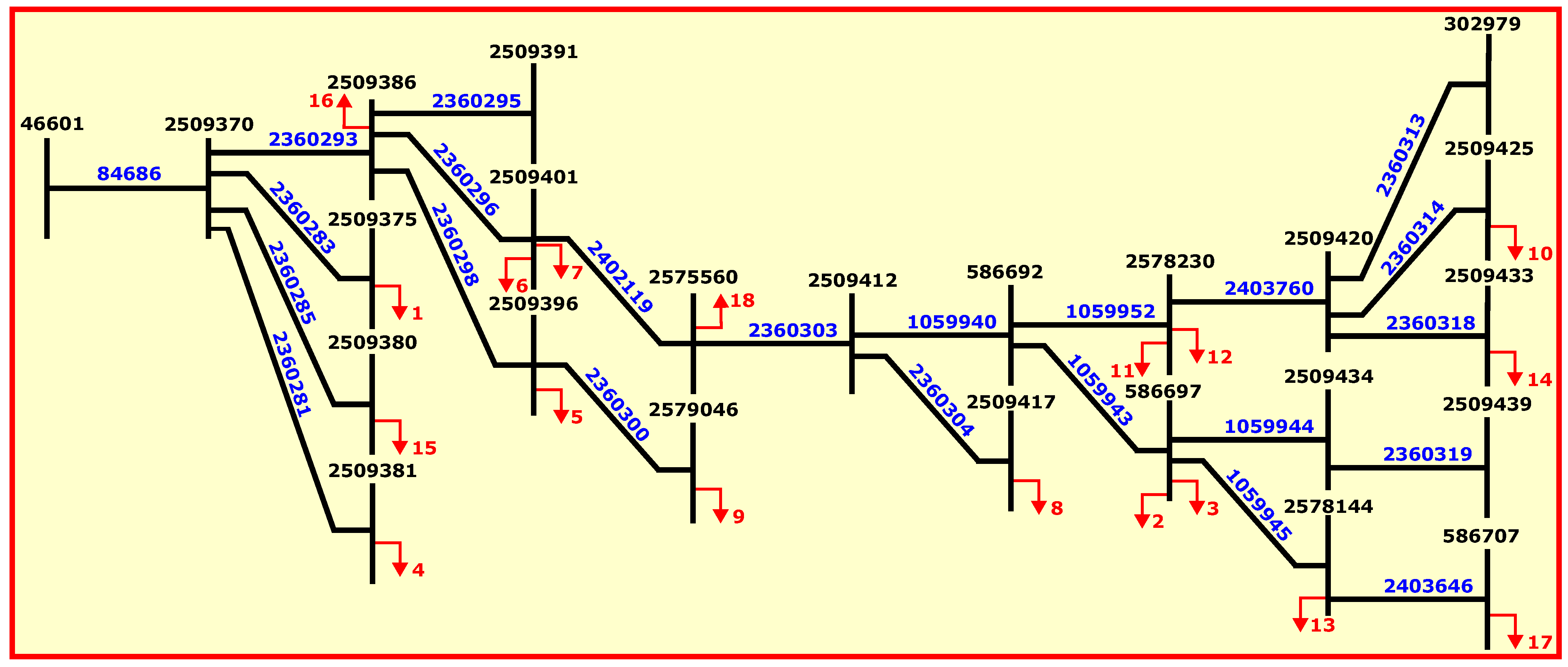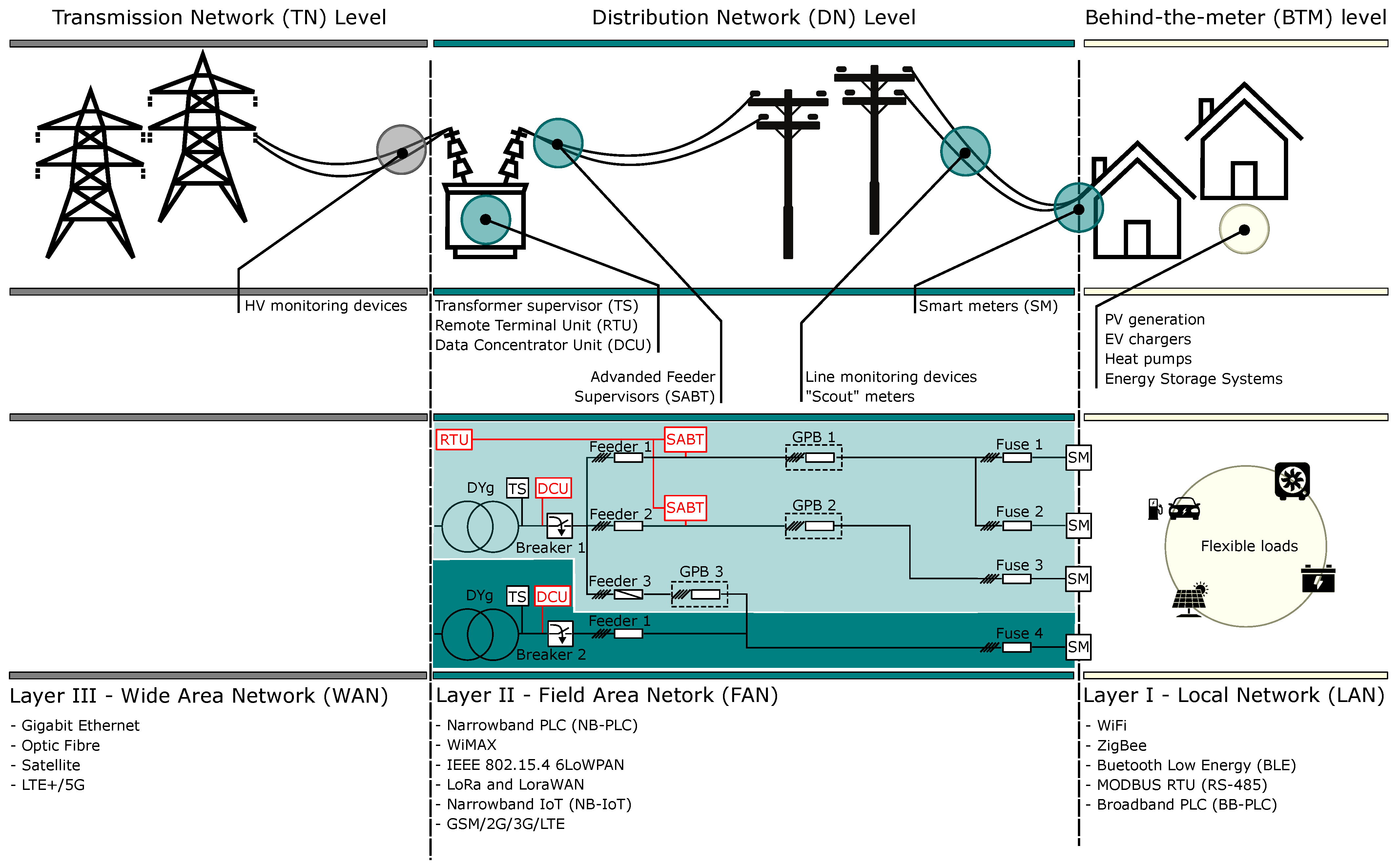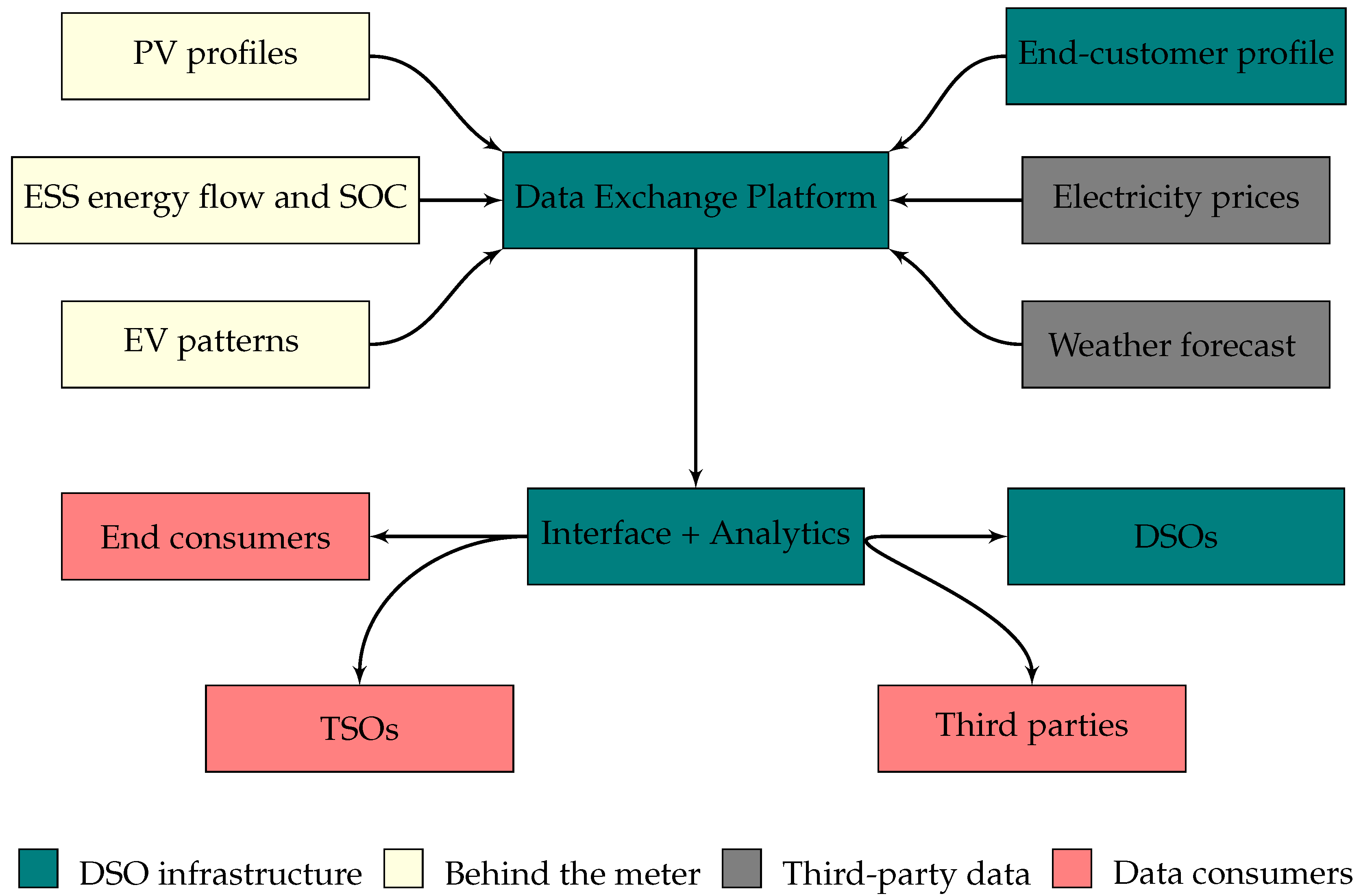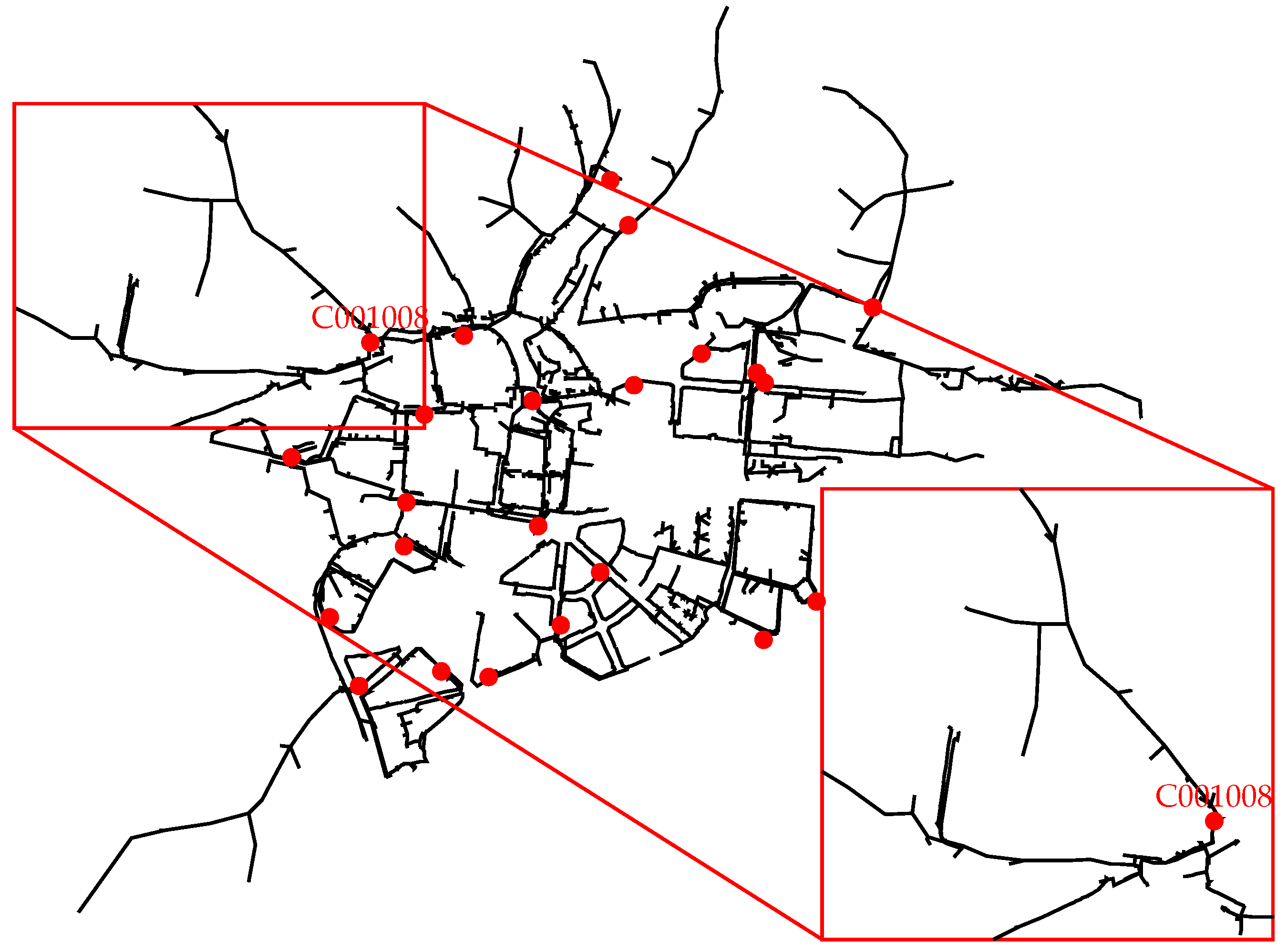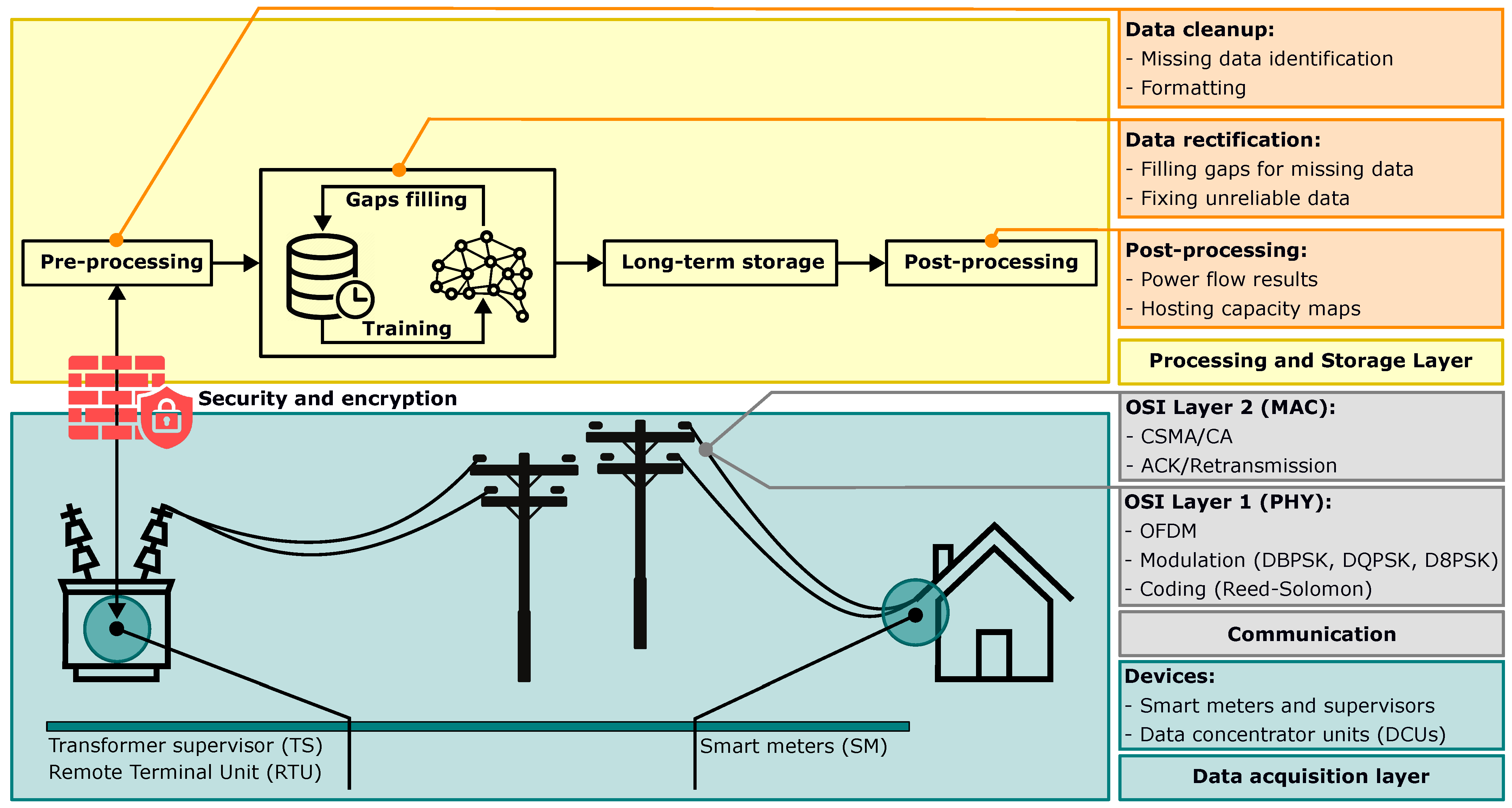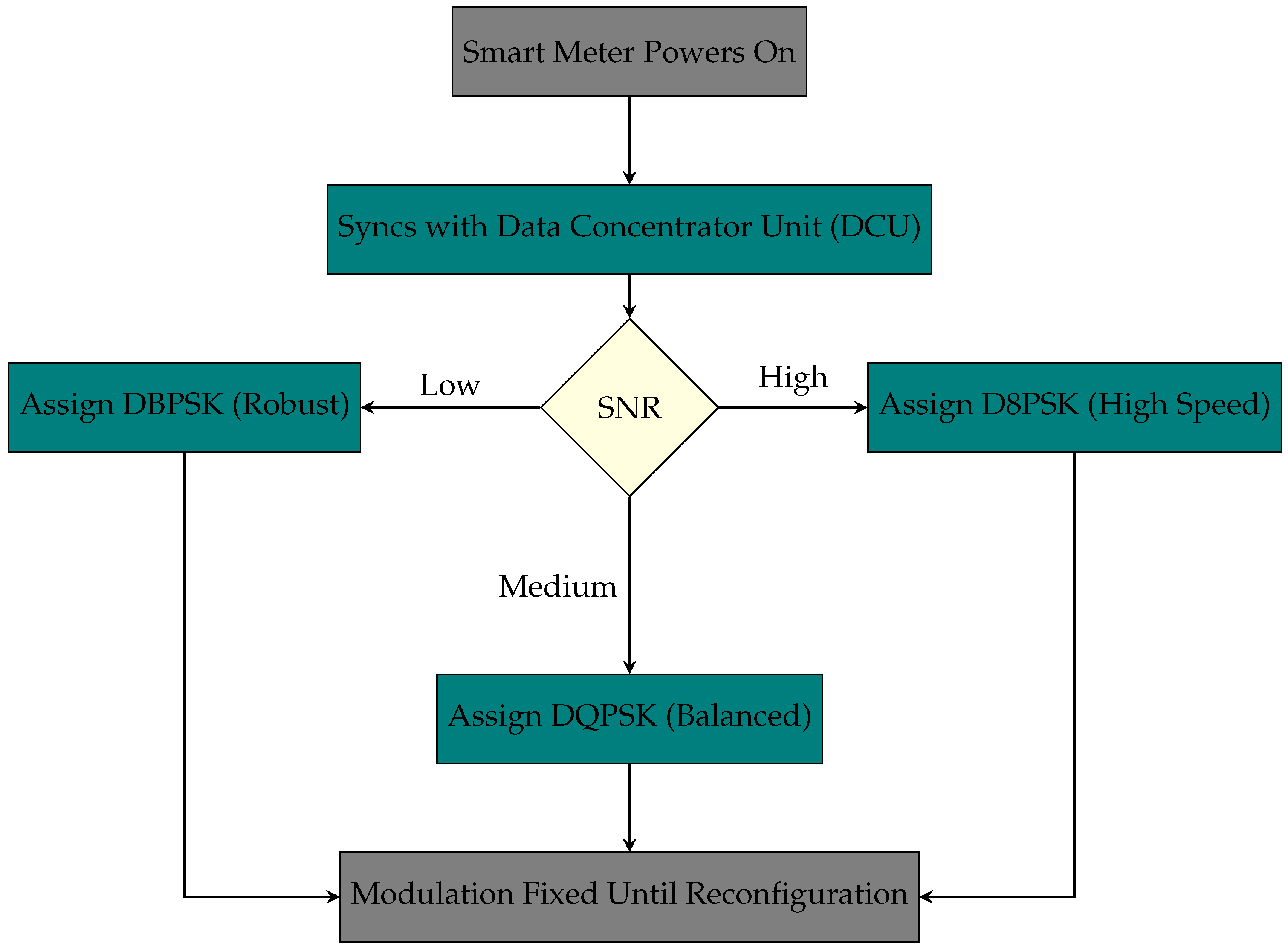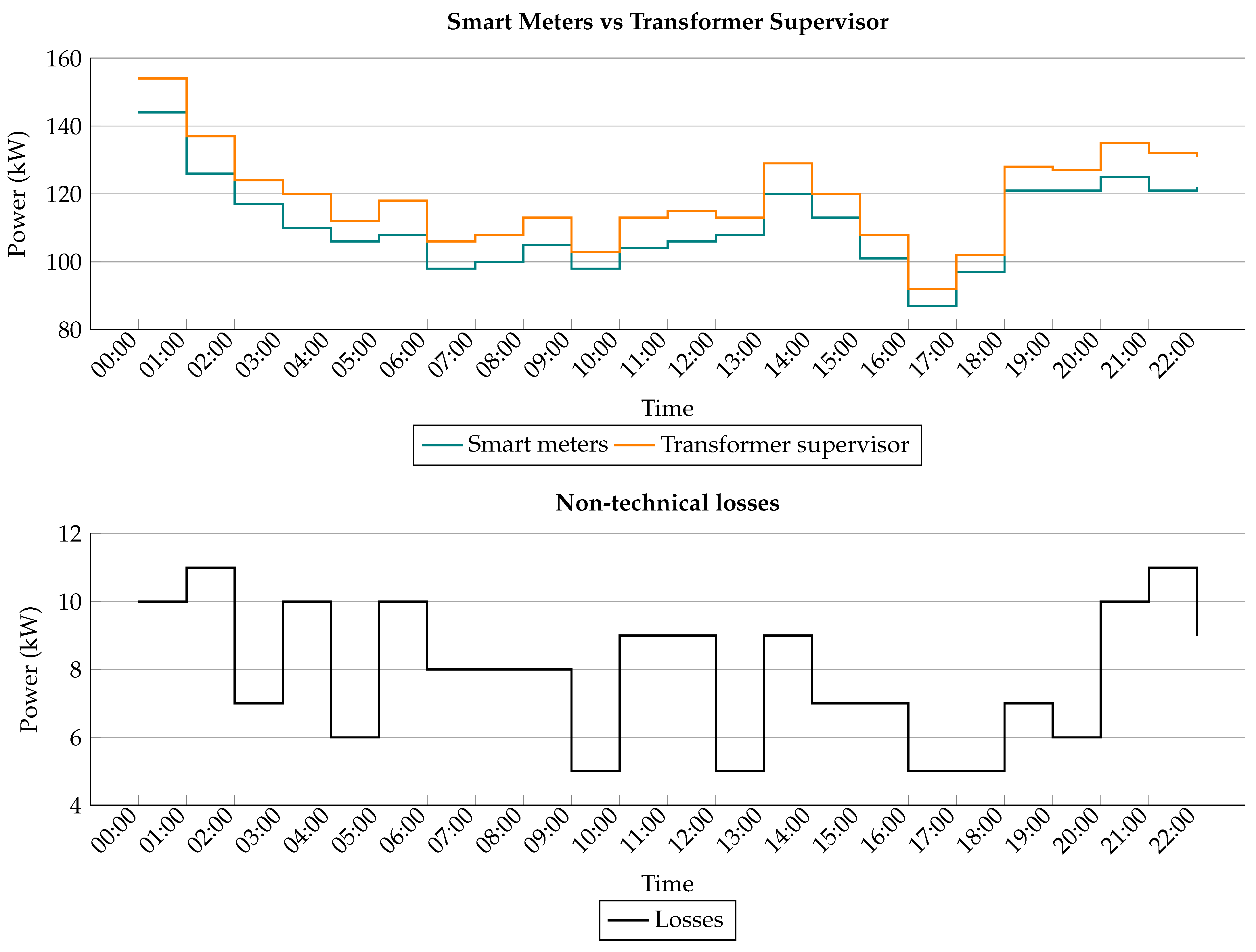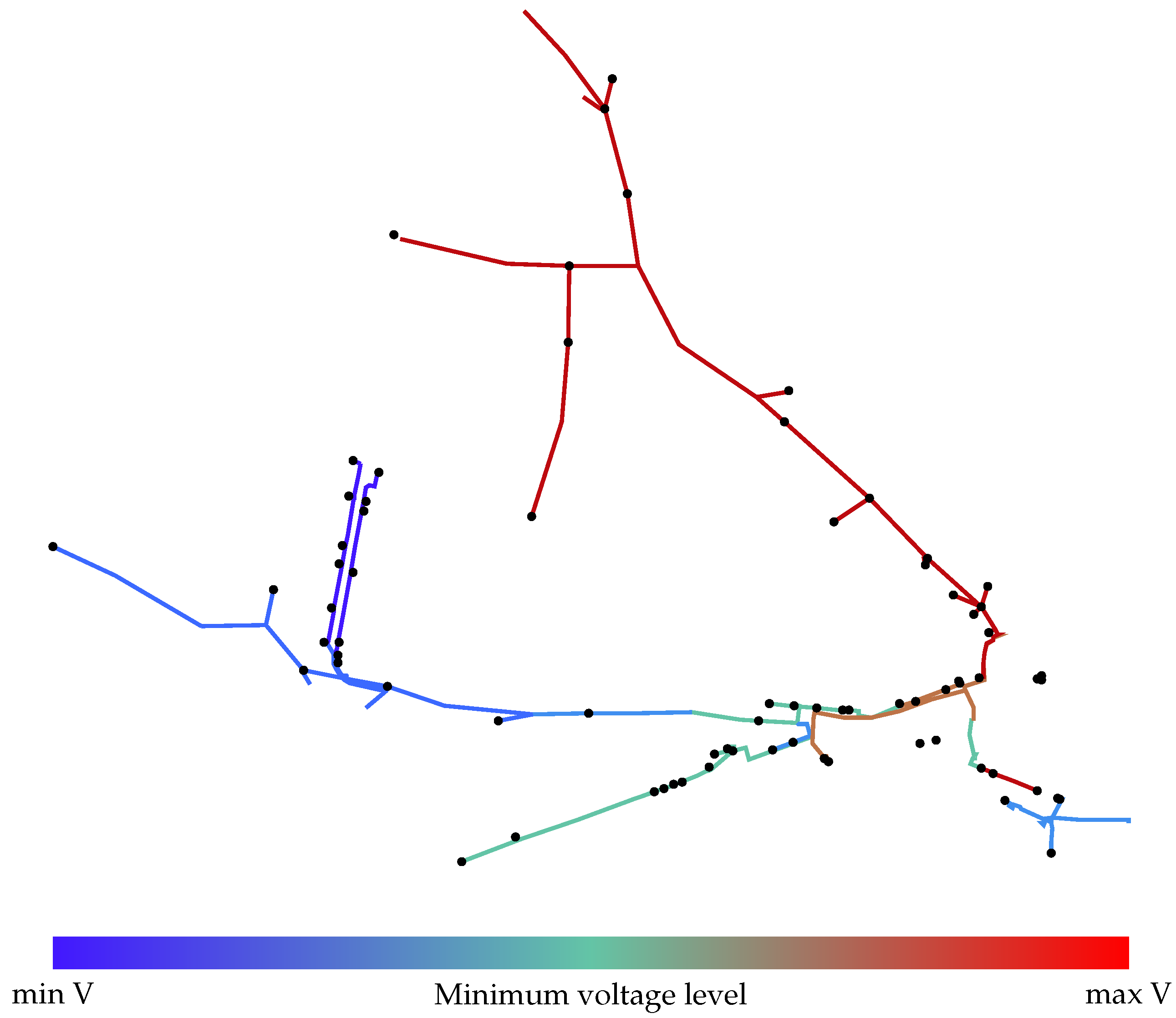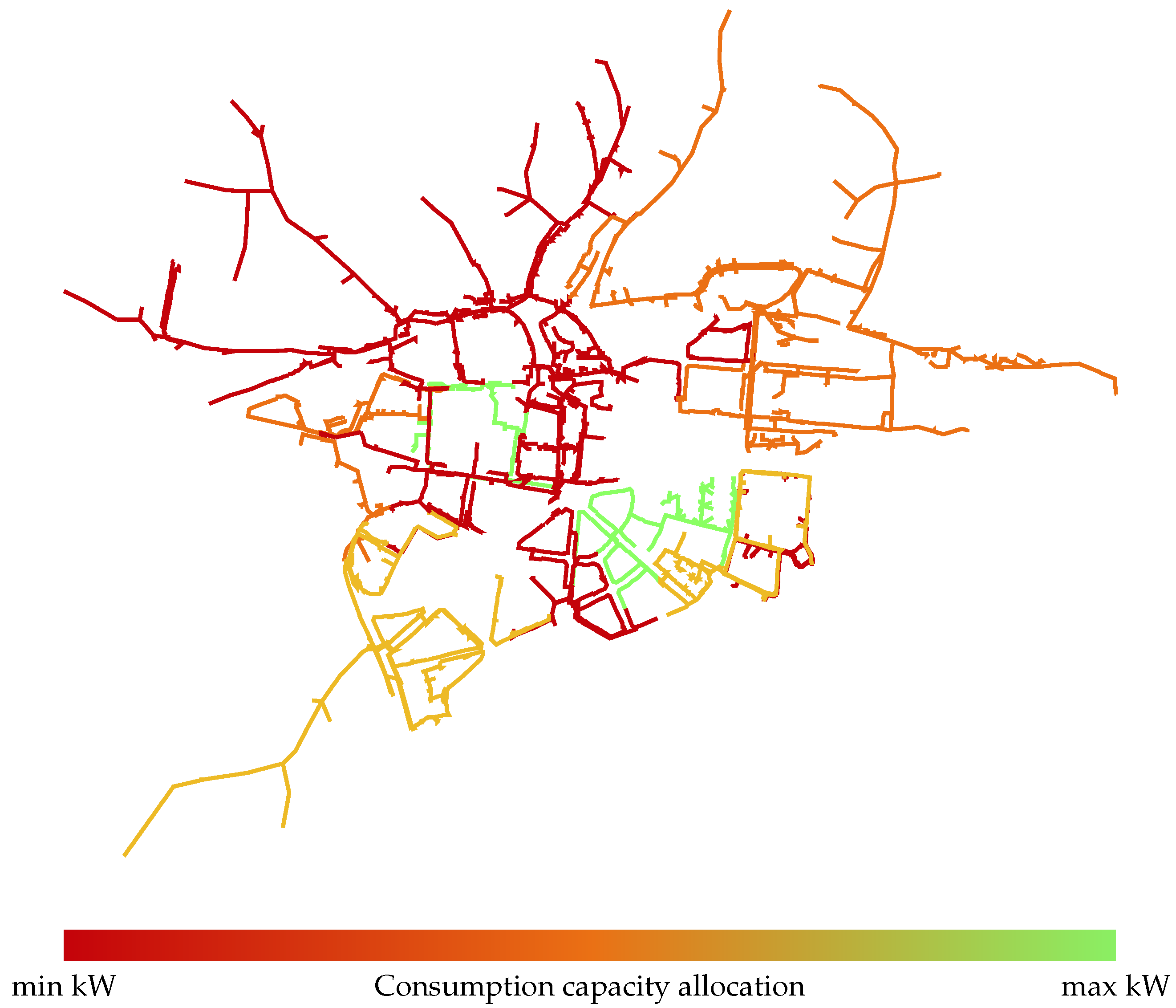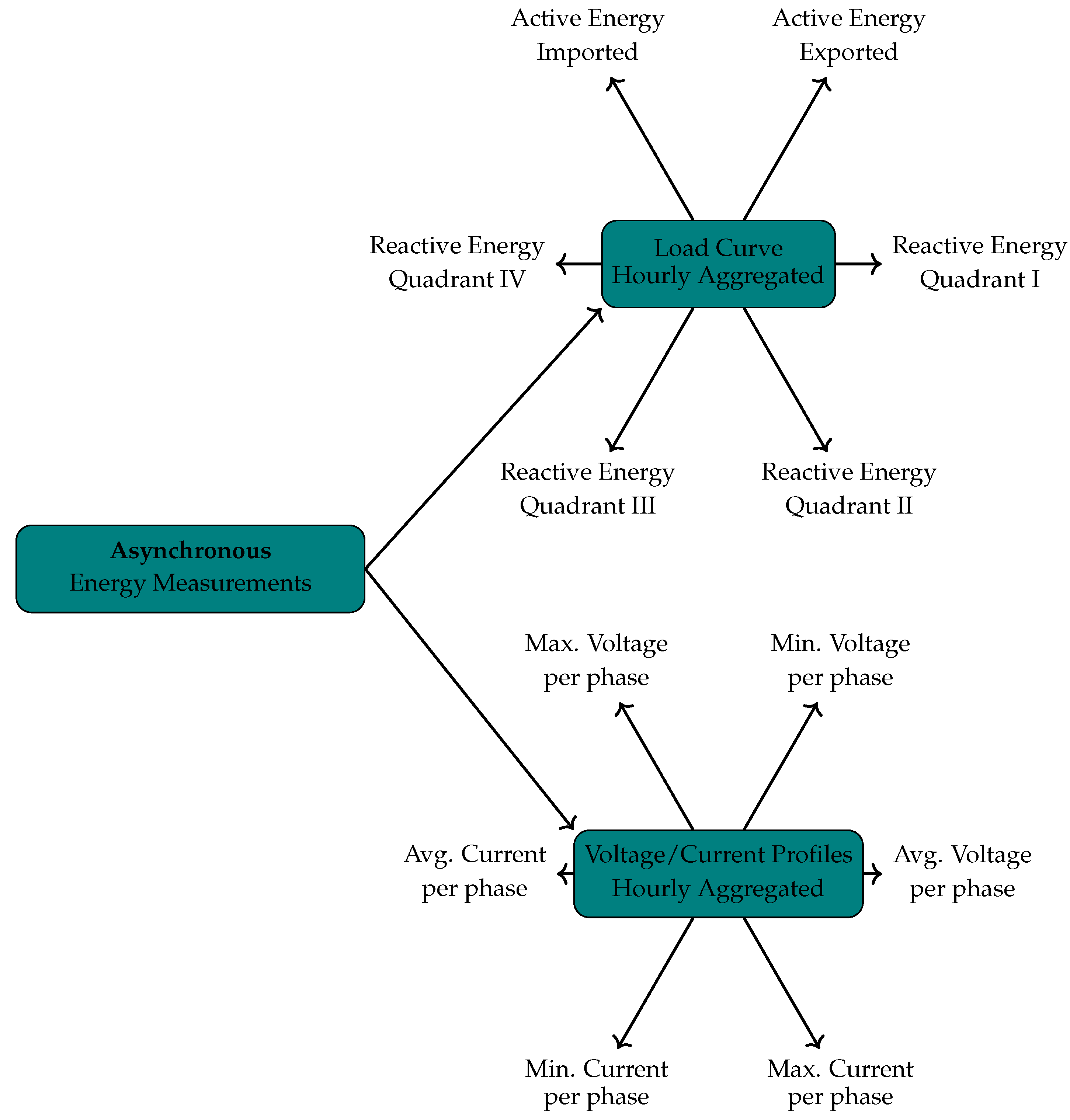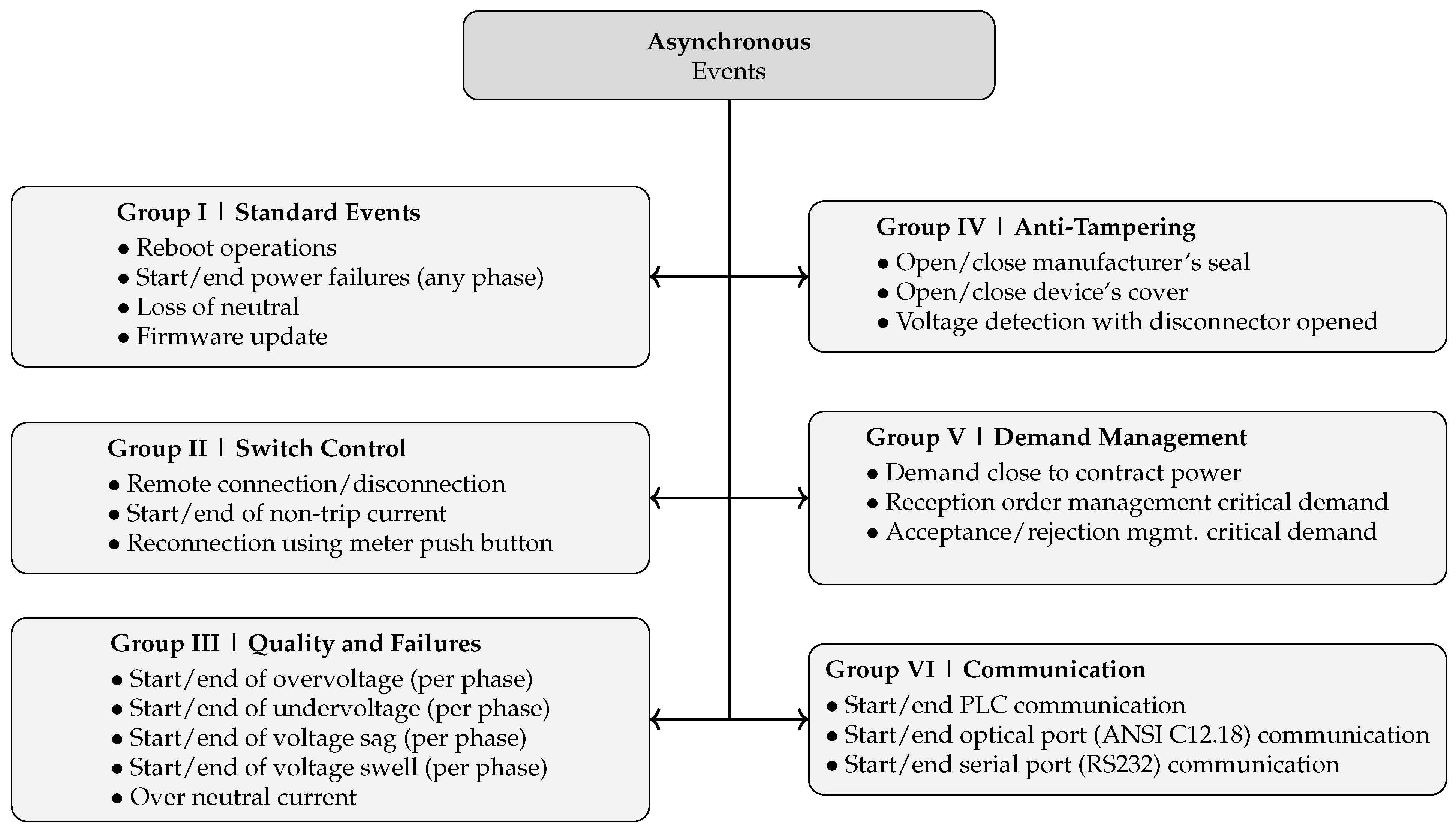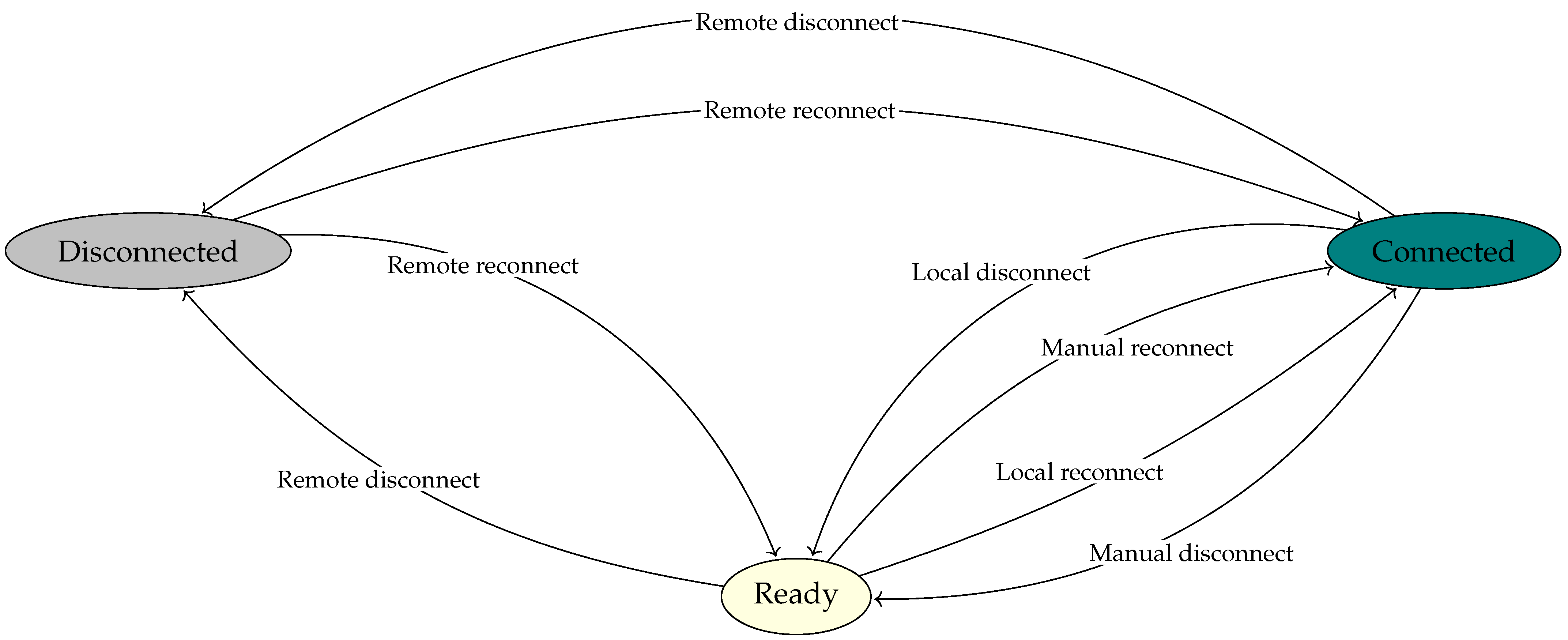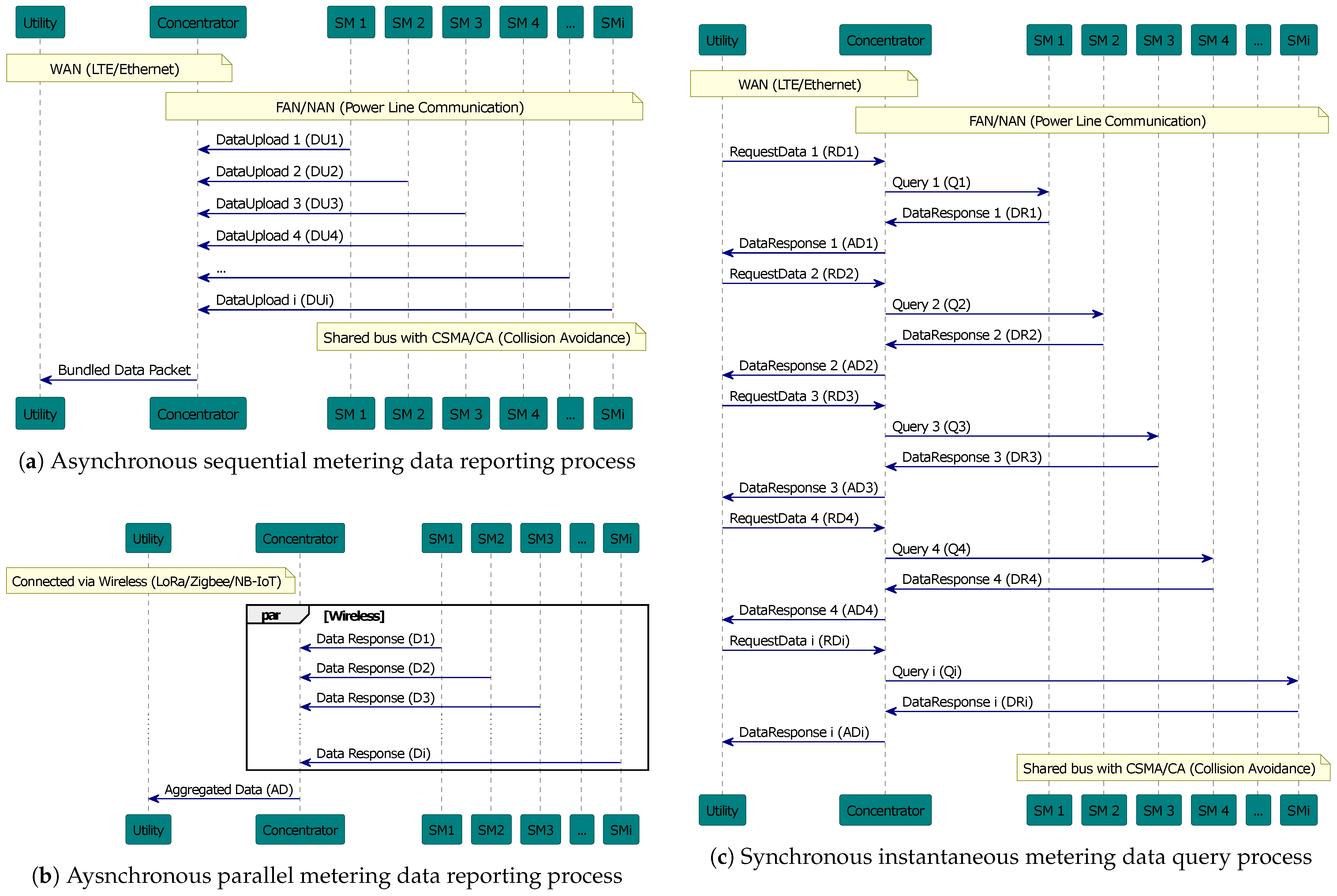1. Introduction
The EU Third Energy Package [
1] and new rules on the Union’s internal energy market [
2] impose not only a massive increase in electricity demand but also a complete and clear activity separation model, promoting a user-centric environment and better visibility for Distribution System Operators (DSOs) as the main solution for increasing renewable energy resource (RES) penetration at the distribution network level [
3].
Smart grids are undoubtedly becoming one of the most disruptive areas in the electrical landscape [
4,
5,
6], and decentralized generation is progressively being preferred over the outdated, traditional unidirectional electricity distribution model. Nevertheless, this change in the global distribution system paradigm also poses great challenges to DSOs. Roles and responsibilities for DSOs will expand [
7], while they face structural, operational, and strategic changes. As the distribution network progressively transitions to a bidirectional model, both for energy and information, the design of a robust and reliable advanced metering infrastructure (AMI) is needed. New actors will emerge (such as energy communities, prosumers, end-customers, small/medium industries with non-firm connections, and aggregators) with different communication requirements, while system operators must be able to manage them under the same infrastructure. The objective of this paper is to present our experience in proposing, designing, and implementing an integrated methodology for managing low-voltage grids. A self-diagnostic AMI infrastructure based on power-line communication (PLC) is introduced, following a decentralized model that relies only on the minimum required information to apply diagnostic methodologies and dynamically manage the distribution network, ensuring correct operability and observability.
This paper is structured as follows:
Section 2 presents the operational and strategic challenges for DSOs, analyzing regulatory and technical barriers in detail. This analysis serves as background for
Section 3, where new communication technologies and structures at the distribution level are discussed. The PLC-based solution and the processing of the collected data are presented in
Section 4, where the self-diagnostic AMI module is described in detail. An in-depth discussion is provided in
Section 5, followed by conclusions in
Section 6.
2. Operational and Strategic Challenges for DSOs
The EU Third Energy Package [
1,
2] defines the DSO as
responsible for operating, ensuring the maintenance of, and developing the distribution system in a specific area, ensuring the long-term ability of the system to meet reasonable demands for the distribution of electricity.
In a traditional environment, fulfilling these tasks required minimal communication at the distribution level, as energy provisioning was conducted in a one-way direction. With the introduction of decarbonization through massive electrification, the highest impact is now concentrated at the distribution grid, which is also the most extensive part of the entire power system in terms of monitoring and data acquisition points. Concepts such as smart grids [
4,
5,
6] and microgrids [
8,
9], along with EU regulations, advocate for the complete dismantling of conventionally centralized structures. This shift places additional pressure on the traditional fit-and-forget approach followed by DSOs, where electricity provision relied on over-designing the network to accommodate a reasonable amount of passive loads for decades.
With the emergence of distributed energy resources (DERs) at the distribution network level—including distributed generation, energy storage, and demand-side response strategies—the traditional role of DSOs will expand [
7]. Distribution networks will become the new gateway for achieving a flexible and decarbonized energy system, while DSOs must also remain neutral facilitators of market-based solutions in the new user-centric grid participation model.
At the same time, DSOs will face structural challenges. Capacity and interconnection requirements for distributed generation located within the distribution network are therefore the responsibility of the DSO [
10], implying that they must address the specific needs of new market participants, such as energy communities, active consumers (or prosumers), distributed storage providers, and aggregators. Additionally, the new user-centric model demands improved visibility and controllability of the distribution network.
Moreover, both power and information flow will become bidirectional. Users will be able to sell surplus energy to the grid, but bidirectional communication is also essential—not only for billing purposes but, more importantly, for maintaining the appropriate balance between generation and consumption. This evolution of DSOs’ responsibilities leaves only two logical solutions for the short-term scenario [
11]:
On one hand, the DSO can still manage the increase in consumption by investing in grid reinforcement (capital-intensive) or CAPEX-intensive grid reinforcement.
On the other hand, the capacity and resiliency of the grid can be improved by incentivizing users to adjust their demand (demand-side management, or DSM) or their generation to support the power system, thus emphasizing investment in active network management (ANM), also defined as OPEX-driven grid optimization.
The first solution matches perfectly with the traditional fit-and-forget approach. As it is expected that the high penetration of distributed generation and massive electrification will require intensive grid reinforcement, this approach normally leads to the use of non-optimal solutions, which tend to cause significant over-investment but considerable under-utilization in return [
12]. Moreover, under the new legislation for the internal market for electricity [
1], to disincentivize the use of solutions that restrict users’ participation with a neutral market focus, the incentives for DSOs and their percentage-based retribution for capital-intensive grid reinforcement are reduced. This means that CAPEX-intensive grid reinforcement also results in higher access tariffs (the fixed part of the energy bill) for end customers.
The second solution, on the other hand, promotes the design of market-based solutions for congestion management. The DSO is encouraged to procure non-frequency-based ancillary services in the distribution grid [
2], which also promotes investment in OPEX-driven grid optimization for dealing with network restrictions due to the massive introduction of high-consumption dispatchable loads (e.g., a domestic EV charger with a rated power of 7.2 kW almost doubles the average contracted power of a typical household, which is around 4.5 kW).
In short, the DSO is able to cope with the new challenges by encouraging users not only to adjust their consumption or generation patterns but also to actively participate in local flexibility markets. However, two types of limitations remain: regulatory and technological barriers.
2.1. Regulatory Barriers for OPEX-Driven GRID Optimization
The regulatory challenges that DSOs have to deal with are based on the definition of their own responsibilities, the emergence of new actors, and how they will interact with each other in a distribution network environment that has not changed significantly in recent years. Some of the regulatory barriers and their effects on the current state of distribution grids can be analyzed as follows:
Flexibility activation: The EU Third Energy Package [
1,
2] promotes the use of flexibility as a non-frequency ancillary service to solve local voltage congestions. Moreover, it encourages DSOs to procure these types of services, which paves the way for the development of local flexibility markets. Explicit flexibility can be procured by direct or indirect means, as presented in
Figure 1. Although direct flexibility activation is not regulated across the EU, Germany is currently the only country with a regulated mechanism allowing DSOs to remotely dim (but not completely curtail) flexible loads through §14a of the German Energy Industry Act (EnWG) [
13]. On the other hand, indirect activation of flexibility refers to pre-contractual conditions between energy retailers and aggregators or individuals with non-firm connections, or flex-tariffs. Although there is a network code proposal [
14], the regulation is still not mature enough to drive market-based solutions for local flexibility activation.Due to the lack of a legal framework, even though DSOs are encouraged to procure non-frequency ancillary resources for congestion management, they are significantly hindered by the absence of a legal mechanism to do so. Flexibility activation will increase the need for a robust, redundant, near-real-time-capable communication infrastructure that can handle information exchange, send commands to flexible devices, and verify the correct activation of flexibility.
EU consumer-centric position: In the context of increasing demand due to massive electrification, the most optimal way to handle the impact on the distribution network is to improve (or maximize) the efficiency of existing resources, thereby lowering access barriers and encouraging end-customers to invest in decentralized generation and local storage based on renewable energy sources (RESs). Placing the user at the center also implies a shift in the DSO’s role: Although they are responsible for encouraging the penetration of renewable resources, they must also manage the network to prevent voltage congestions while remaining a neutral market facilitator. Despite OPEX-driven grid optimization being the preferred approach to reducing overall costs for both DSOs and end-customers, responsibilities are often subject to unregulated scenarios where user promotion is simply not feasible.
Energy storage systems: The EU’s stance on local storage systems is challenging, as it explicitly states that distribution system operators must not own, develop, manage, or operate energy storage facilities, as storage services must be based on market mechanisms and therefore cannot be implemented by agents whose activity is regulated. Therefore, DSOs can only own a storage system when it is fully integrated into their network and not used for balancing or congestion management. Undoubtedly, the adaptation of distribution networks and their metering and communication infrastructures is one of the critical factors for achieving significant penetration levels of distributed resources.
Energy communities as an emerging actor: Energy communities offer a mechanism through which members or partners can participate in electricity markets as a collective entity represented by the community itself. The implementation of such communities not only enhances energy efficiency and environmental benefits but also enables certain consumers to share in the benefits of different electricity markets. Regulations allow these energy communities to establish their own distribution networks and even operate as electricity distributors with full rights and duties. Closely aligned with the micro grid concept [
8], energy communities could function as cells within the broader distribution system environment, necessitating a proper communication infrastructure with the DSO.
Smart meter rollout goals have to be promoted by regulatory entities. The EU has already initialized the process, conditioned under a positive cost–benefit analysis (CBA) [
15], and continues analyzing the evolution of the smart metering rollout [
16]. The current status of smart metering penetration is depicted in
Figure 2. Specifically in Spain, the metering rollout has reached a penetration level of 100%, and the second-generation rollout has already begun for all connection points in the low-voltage distribution grid with a contracted power of less than 15 kW [
17]. Moreover, every end-user must have remotely managed smart meters installed, allowing for remote reading of consumption. Additionally, distribution companies are required to provide consumers with real data on their hourly consumption [
18], a key measure to encourage active user participation in energy management, in line with the user-centric model driven by the European Commission.
2.2. Technological Barriers for OPEX-Driven Grid Optimization
Technological barriers are more related to the way distribution grids are currently being exploited. The massive introduction of decentralized generation in a traditionally unidirectional ecosystem calls for a new exploitation model capable of adjusting both consumption and production in near-real time. Since RESs are generally characterized by their fluctuations—being unpredictable, volatile, and intermittent [
19]—local issues (e.g., voltage control and congestion) are prone to occur due to active power injection. Therefore, the controllability of RESs is one of the critical requirements that DSOs must address, either through direct or indirect methods (e.g., flexible tariffs), as depicted in
Figure 1.
Still, the lack of key characteristics for effectively metering and controlling the vast number of emerging devices in low-voltage distribution grids poses a significant structural challenge for DSOs. Smart metering penetration could be a viable solution, but only if the necessary requirements are successfully met. Higher data granularity is often directly proportional to larger investments, whether in dedicated metering infrastructures or low-latency communication protocols for smart meters with advanced features. Technological barriers can be analyzed as follows:
Submetering: Also called behind-the-meter devices, these assets are often associated with flexible types of loads (PV panels, energy storage, EV chargers, and heat pumps). The traditional metering approach considers the smart meter as the division point between the DSO’s assets and customer premises. However, it is precisely on customer premises where the greatest impact of massive electrification occurs due to flexible loads or distributed generation.
Neither controllability nor data acquisition from these types of devices is regulated, despite standardization efforts such as the IEEE Standard for Smart Energy Profile Application (2030.5) protocol [
20] or Open Automated Demand Response (OpenADR) [
21], which have been proposed but have failed to gain widespread acceptance. Moreover, the large-scale integration of renewables into low-voltage distribution grids is only feasible when decision-making is based on both smart metering data and submetering information. Hosting capacity maps, for example, would be a valuable tool for DSOs to determine which areas require immediate grid reinforcement.
Decentralization: Dividing the network into smaller segments rather than managing everything from a central control structure is an emerging strategy to reduce the computational burden on centralized computing centers. DSOs can take advantage of the naturally radial structure of distribution networks to manage data gathering and processing at the MV/LV transformer level, thus reducing the acquisition request time from the centralized unit and enabling local decision-making.
Aligned with the concept of edge computing, the main advantage of this approach is the reduction in latency by processing information closer to the data sources. However, achieving the decentralization of grid structures in the low-voltage domain requires combining the radial-network structure with industrial-certified computing devices, advanced communication infrastructures, and near-real-time control features. Similar to the concept of microgrids introduced by Lasseter nearly two decades ago [
8], decentralized radial networks with a high share of renewables may act as independent network entities, with a network energy management system responding to events and local constraints, as depicted in
Figure 3. For the utility, this decentralized network slice will appear as a single dispatchable load, while end-customers can become providers of local stability solutions.
Digitalization and dynamic grid management: The transition from a fully conventional and predictable distributed consumption model to one where end users can also act as electricity producers represents a paradigm shift that will undoubtedly bring advantages such as increased efficiency and the democratization of energy.
At the same time, active network management (ANM) requires interaction between network planning strategies, generation connection arrangements (e.g.,
flex tariffs), and real-time network management [
12]. This also necessitates the complete digitalization of the low-voltage distribution grid, leading to a significant increase in the amount of processed data. Concepts such as
big data management must be integrated with data from multiple sources and devices, ranging from behind-the-meter customer premises to advanced line monitoring devices.
From a dynamic grid management perspective, managing energy flows in the distribution network also means optimizing the use of existing infrastructure, thus delaying (or even avoiding) capital expenditures for grid reinforcement, which is considered a last-resort solution.
To meet the above challenges, a radical change in the way distribution systems are managed is essential. It is necessary to implement a digitalization strategy that enables semi-automatic or automatic operation of both the distribution systems themselves and the devices integrated within them. This is the only way to achieve a massive and coordinated penetration of these devices in distribution systems, reducing investment in infrastructure and maximizing the efficiency and sustainability of the entire system.
Despite the existing regulatory and technical barriers, the status of smart metering deployment in Spain provides an ideal scenario for the design, study, and implementation of advanced measurement platforms and the dynamic management of low-voltage networks. The following section will analyze the new communication technologies being integrated at the distribution level, with a special emphasis on a PLC-based smart metering infrastructure.
3. New Communication Technologies at Distribution Level
Grid monitoring is a widely covered topic in high-voltage grids, primarily because transmission grids consist of fewer assets and physical buses. The introduction of automation and digitalization in such networks was not only necessary due to security constraints and the need to maintain a close balance between generation and consumption but also because the number of monitoring devices required to achieve full observability in transmission networks is relatively small compared to distribution networks.
In distribution networks, DSOs have historically relied minimally on metering at the distribution level, except for aggregated measurements at the MV/LV transformer level. For billing purposes, manual meter reading at end-users’ connection points was the standard practice until the initial deployment of automatic meter reading (AMR) devices for cost reduction marked the first step toward a scalable metering infrastructure [
22], even though observability and control were not the primary objectives.
However, with the increasing penetration of DERs and flexible loads in low-voltage distribution networks, observability and supervision have become critical topics for DSOs. Bidirectional information flow characterizes emerging smart grids, providing both customers and DSOs with near-real-time access to metering data. Since the introduction of smart meters and remote management systems, LV network observability has increased significantly. Moreover, as digital devices continue to be deployed across the network, the volume of available variables, information, and measurements will expand, while new equipment and applications will continue to emerge.
Metering infrastructures play a pivotal role in any distribution monitoring and observability system. Communication is the key enabling technology for this implementation, yet designing robust physical, data, and network communication layers remains a significant challenge. The design of any communication network should always be preceded by [
23]:
The functional requirements specification, which describes the business and corresponding technical needs that drive the design.
The actual infrastructure architecture.
In the Spanish case, the functional requirements specification and primary motivation for the DSO are to gather data on customer behavior and grid status to advance toward a digital network twin that reliably replicates the entire system’s status for both planning and operation. Therefore, a deeper understanding of the advanced metering infrastructure management system and its interaction with the electricity grid is essential.
The infrastructure architecture, which leverages existing power lines to transmit both readings and basic commands bidirectionally, will be described in detail in the next subsection.
3.1. PLC-Based Advanced Metering Infrastructure
PLC communication has been chosen as the main technology due to its reduced costs, the reuse of an already deployed infrastructure (leveraging existing power lines), and the fact that an external company is not required for infrastructure maintenance and operation, as the assets belong directly to the DSO.
A detailed description of the current metering infrastructure is presented in
Figure 4. Data acquisition devices are typically associated with a specific controlled device, as specified in
Table 1. Specifically for the distribution network, in order to utilize the PLC network effectively, the metering asset must be associated with an element connected to the electrical grid, as the power and communication channel are shared.
Smart meter (SM): The main data acquisition device, connected at the user’s point of connection with the grid. It often represents the last managed device (also called the last-mile) by the DSO. Providing single- or three-phase readings aggregated per hour (contadores de telegestión in Spanish), it also incorporates remote connection/disconnection functions that are handled by a central management platform.
Transformer low-voltage supervisor (TS): Acting as a traditional three-phase smart meter, it provides additional insights into the aggregated power measurements in the radial-structured distribution network. Since the TS is closer than any other device to the MV/LV station, it often provides shorter response times for requests made by the DCU. In some cases, the TS and DCU are built into the same equipment, simplifying installation and data acquisition procedures with little to no latency.
Data concentrator unit (DCU): One of the key devices in the entire PLC AMI infrastructure, it acts as a router between the PLC smart metering network and a broadband (Ethernet/LTE/fiber optic) connection with the central management unit on DSO premises.
In short, the PLC AMI network consists of three main devices: end-customer smart meters, transformer supervisors, and a router-type device called the DCU. Over time, the DSO has incorporated additional metering devices, though not all of them are connected to the PLC network. A more detailed description follows:
Line supervisors/scout meters: Secondary supervision meters, also called scout meters, are three-phase smart meters strategically positioned to provide a more detailed analysis of distribution grid behavior. In some cases, three-phase meters associated with industrial consumption that report measurements using the IEC 61850 protocol via a GSM modem (contadores de telemedida in Spanish) are also used as secondary supervision meters. However, this is a vestigial approach from the early measurement days, and these meters are progressively being replaced to take advantage of the PLC network’s features.
Line supervisors, on the other hand, remain an unexplored technology that could be utilized in the future for advanced applications such as dynamic line rating (DLR).
Advanced low-voltage supervisors (SABT): These measuring devices provide more data than traditional single- or three-phase smart meters located at the transformer level. Positioned at low-voltage feeder outputs, they offer greater data granularity and shorter response times. Due to their proximity to the MV/LV transformer station, they typically leverage Ethernet/LTE/fiber optic connections through a remote terminal unit (RTU).
A PLC-based infrastructure presents several advantages for DSOs (
Table 2). The most significant advantage is the substantial cost savings associated with deploying the communication infrastructure. The primary motivation for DSOs to adopt PLC-based technology is that the low-voltage electrical conductors to which smart meters are connected serve as the physical communication path.
Utilizing the power-line network as a metering infrastructure significantly reduces capital expenses (CAPEX) required for deploying any metering system, as the distribution network itself functions as a ubiquitous communication network. When combined with a protocol that supports a self-discovery procedure, such as PRIME v1.3.6 [
24], integrating metering devices becomes a relatively straightforward task. Moreover, since underground cables and overhead lines (which constitute the communication channel) belong to the DSO, no external party is required for infrastructure maintenance or data exchange.
The infrastructure itself is easily maintained, with the DSO acting as both the provider and consumer of information. Since the communication infrastructure is built on top of the distribution network, topological information can be derived from the received measurements. Not only does the PRIME protocol include specific reports for communication statistics—allowing DSOs to identify potential connectivity problems or outages in near-real time—but the DCU also maintains a list of all meters connected to and reporting through it. Consequently, the switching status of line breakers and fuses within the distribution network can be easily inferred from the topological information provided by the DCU [
25], in combination with other data sources such as the DSO’s proprietary SCADA model.
On the other hand, PLC infrastructures are jeopardized by the massive introduction of switching devices in the low-voltage distribution grid. Essentially, every flexible load will have an inverter-based AC/DC interface with the grid, and without proper filtering at the point of common coupling (PCC), supraharmonics (multiples of the switching frequency) fall within the CENELEC-A communication band (9 kHz–95 kHz). While extensive research has been conducted in the field of electromagnetic compatibility (EMC) for frequencies up to 3 kHz [
26], little attention has been given to the communication frequency window used for PLC smart metering.
Using higher frequencies in the regulated spectrum (CENELEC-B and CENELEC-C bands) is restricted by EU regulations [
27], even though some markets provide services using PLC communication up to 500 kHz, which could potentially mitigate this issue. Another disadvantage of PLC technology is that communication is entirely lost if physical damage occurs in the distribution network.
Being an outage-intolerant network, this characteristic allows for the rapid identification of electrical failures in the grid, but it also means that communication with end devices is lost in such events. This would not be a critical issue if only smart meters were deployed in the network, but with the increasing adoption of behind-the-meter devices, end users could simply switch to grid-islanding if they have local energy storage systems. In such cases, the DSO would lose visibility over those devices, as the network would essentially be offline.
3.2. System’s Scalability
The scalability of the proposed system is highly dependent on the physical structure and potential congestion of the distribution network as a communication channel. On one hand, PLC-based AMIs benefit from the inherently radial topology of low-voltage distribution networks, as this structure simplifies communication paths and reduces complexity. Since each smart meter is typically connected along a single feeder path, the network can operate using a predictable, tree-like hierarchy. Nevertheless, as pointed out in
Table 2, this dependency on topology makes the proposed AMI non-tolerant to network outages.
The system’s scalability can also be interpreted as the ability to allocate a growing number of metering devices that make use of the existing infrastructure, without affecting the reliability and latency. One of the key advantages of PLC is the self-discovery capability, which allows smart meters to autonomously identify and establish communication paths within the network without manual configuration. This feature greatly simplifies large-scale deployments, as meters can automatically detect nearby DCUs, join the appropriate communication tree, and begin data exchange with minimal manual intervention. Moreover, when topological changes occur (e.g., a feeder reconfiguration), meters are able to dynamically reassociate with alternative concentrators. Limitations in the system’s scalability can be classified as:
Channel’s communication constrains: The channel is only capable of allocating a finite number of metering devices until the combination between normal traffic and channel background noise constrains the channel in such a way that introducing new devices will affect the previously working system. The massive introduction of PLC-based DERs could not only have an impact given the channel’s limitation but also due to the higher noise probability.
LV network’s physical constrains: The channel’s natural attenuation is directly related to the feeder’s length, thus a length extension in a radial-shape, LV-network will cause weaker signal reception. PRIME deals with weaker signals by allowing meters to become repeaters alongside the network, once the SNR falls below a certain threshold. Nevertheless, increasing the number of repeaters also means more retransmission, thus constraining the channel’s capacity, as it is a shared medium.
It is worth noticing that PLC PRIME has been specifically designed for deployment in radial low-voltage (LV) distribution networks, which constitute the vast majority of LV topologies across Europe. The architecture design is optimized for tree-like structures with a single communication path toward a DCU located at the substation level. Initially, PRIME was not intended for operation in meshed LV networks, where multiple communication paths and dynamic topology changes introduce complexities that exceed its native protocol capabilities. Therefore, the potential evolution towards non-radial LV networks will require further research in more appropriated communication infrastructures, such as meshed-type networks.
3.3. Data Exchange Platforms
Since data sources are expanding rapidly, a combination of metering infrastructures is needed. PLC has proven to be a reliable solution for delay-tolerant data acquisition (e.g., once a day), but integrating PLC metering infrastructures with additional data sources and communication technologies could provide enhanced services for DSOs.
When it comes to network data acquisition, the challenges for DSOs are well defined: while a PLC-based metering network alone can offer sufficient insights for planning purposes, it also presents certain drawbacks. Moreover, the massive penetration of DERs in the low-voltage grid is expected to degrade PLC-based communication performance, potentially jeopardizing the planned infrastructure.
On the other hand, devices that provide additional insights typically rely on alternative communication infrastructures. Thus, the challenge for DSOs is to leverage as many available devices and communication technologies as possible to gain a comprehensive view of the grid’s power flow. However, the lack of a standardized protocol for managing behind-the-meter devices further compromises grid visibility, as the DSO can only measure aggregated energy consumption and injection at the supply point.
Combining information from different data sources and layers and utilizing a data exchange platform, as depicted in
Figure 5, could serve as a viable solution for future applications, offering DSOs access to more data sources and greater granularity. Additionally, other external data consumers could benefit from such a platform. For instance, TSO-DSO coordination could facilitate the design of frequency ancillary markets, given that the decentralization of power systems is shifting potential reserve capacity to the distribution level [
28].
Beyond power flow analysis, active and reactive power measurements alone are not sufficient. Communication events also provide valuable insights that can be used for fraud prevention, outage detection, and other applications. The following section presents a data-driven self-diagnostic AMI module, based on experience with data collected through the PLC-based AMI in the Spanish low-voltage distribution network.
4. Self-Diagnostic AMI Module
For enabling high penetration of
microsources (less than 100 kW power rating) in low-voltage distribution grids, voltage regulation is necessary for local reliability and stability, which cannot be achieved with simple locally managed PQ control features on the devices [
8]. A more detailed analysis is required, both for improving grid observability and coordinating loads.
The core of this research on the Spanish low-voltage distribution grid metering infrastructure is based on the implementation and development of network monitoring systems and digital twins—innovative technologies that enable an accurate virtual representation of physical networks. This is essential for optimizing system operation and improving visibility. The proposed self-diagnostic module demonstrates that integrating digital twins into low-voltage grids significantly enhances system management and operation. This approach has been explored and validated through extensive theoretical and practical analysis, proving that these virtual models can provide a comprehensive, real-time picture of the network’s state.
The advances achieved not only enable the identification and prediction of potential failures but also facilitate the effective incorporation of distributed devices, thereby promoting greater flexibility and sustainability in the network. An AMI system is a complex application that can integrate multiple functionalities, adapting to the needs of smart grids. Extensive research in the literature covers various approaches to AMI systems, including scalability for network expansion [
30], encryption [
31,
32], massive data processing [
33,
34], and real-time measurements from end-customers [
35].
The proposed self-diagnostic module is essential for:
Optimizing power flows and energy redistribution in the grid, identifying weak points, and providing useful insights for designing more effective algorithms and load management strategies.
Detecting failures and anomalies before they trigger massive outages and service interruptions.
Identifying potential fraud, based on smart meter events (both asynchronous and instantaneous).
Increasing the overall resilience of the system.
The combination of metering and topological analysis from the AMI module is integrated with data from the DSO’s SCADA and Geographical Information System (GIS). This introduces a novel way of interconnecting data for both topology and measurement analysis. When these sources are combined, valuable insights into power flow and grid status can be obtained.
The following subsections will present the results of the AMI module implementation, focusing on both topological and power flow analysis.
4.1. Equipment Inventory and Network Assets
DSOs typically obtain their topological information from the GIS system; however, the characteristics of each device are often limited or stored in different locations. The characteristics of assets can be enumerated as:
Overhead line conductor type and length.
Underground cable insulation material and geographical position.
Transformer ratings and resistance/reactance per phase.
Number of customers and the unique identification number of each meter connected at each supply point or general protection box (CGP).
Fuse/disconnector positions and status along the network.
Being able to graphically identify whether an asset belongs to a specific network would be a valuable feature. As shown in
Figure 6, by combining information from the PLC network and GIS, each network can be isolated and analyzed separately. This also enables the recognition of interconnections between different networks and the potential rerouting of customers from one supply station to another when needed.
This topological information is further integrated with SCADA to map the status of switches and disconnectors across the distribution network, identifying potential loops or misconfigurations. Moreover, merging this information with the DSO’s asset database allows for a graphical representation where an asset’s location is not only displayed but also identified, along with its electrical characteristics.
4.2. Data Processing and Integration
Using the same channel both for power transmission and communication might be a non-expensive way to reach as many metering points as possible, but the main drawback lies on the unsuitability of the power line as a dedicated media link. Power lines are not designed for data communication, so signals suffer from attenuation, reflection, and interference. Although presenting several advantages as previously depicted in
Table 2, PLC has demonstrated to be an environment prone to different types of noises [
36,
37]:
Colored background noise.
Synchronous impulsive noise.
Asynchronous impulsive noise.
While the first one nearly affects all frequencies equally, and the second one is periodical and synchronized with the grid frequency, the third type is completely unpredictable [
38] and highly frequency-selective. Although many approaches have been developed to model and mitigate noise affecting PLC communication [
39], the increasing number of distributed energy resources pose a threat to these data collection infrastructures.
Considering not only the influence of asynchronous impulsive noise but also the increasing effect of supra-harmonics in PLC data collection systems, data losses are prone to happen. But if the main goal is to keep PLC as the preferred communication infrastructure for metering, then only two solutions can be envisaged:
mitigate and
rectify. Data processing and integration mechanisms can be defined in
Figure 7.
4.2.1. Noise Mitigation
Mitigation refers to all the efforts and technologies that are put in the data collection process, affecting directly the improvement of the signal-to-noise ratio of the PLC signal. The big three standards used for PLC communication in Europe (PRIME in Spain/Portugal, G3-PLC in France, and Meters&More in Italy) deal with noise in different fashions: while G3-PLC prioritizes noise mitigation and robusteness by dynamically adapting the modulation per carrier frequency depending on the actual signal-to-noise ratio, Meters&More uses a single-frequency transmission with time division multiple access (TDMA) to avoid collisions, which makes it faster but more prone to noise.
The standard deployed in the Spanish LV AMI network, PRIME v.1.3.6 [
24], uses the CENELEC-A band between 3 kHz and 148.5 kHz, which unfailingly falls in reach of multiples of the switching frequency of inverter-based loads. Therefore, mitigation involves the use of several modulation or transmission techniques to prevent or minimize the probability of data loss at a physical layer level.
Techniques in use can be described in detail in
Table 3: Noise mitigation in PRIME v1.3.6 is primarily implemented at the first two layers of the OSI model—the physical (PHY) and data link (MAC) layers—directly impacting signal treatment and media access behavior. At the PHY layer, Orthogonal Frequency Division Multiplexing (OFDM) spreads the signal across 97 subcarriers to avoid narrowband interference, while modulation selection (DBPSK, DQPSK, D8PSK), as shown in
Figure 8, balances robustness and speed. Reed–Solomon coding introduces redundancy to recover from burst errors without retransmission. At the MAC layer, CSMA/CA prevents collisions by deferring transmissions during noisy periods, and ACK/retransmission mechanisms ensure data integrity.
4.2.2. Data Rectification
When all traditional noise mitigation strategies—such as OFDM subcarrier spreading, static carrier masking, forward error correction, CSMA/CA-based access coordination, and retransmission mechanisms—are not sufficient and the metering device unit ultimately discards a data packet attempt due to repeated timeouts or missing acknowledgments, system-level data estimation or rectification mechanisms become essential to ensure continuity in energy monitoring and analytics. In such cases, time-series databases play a critical role in preserving long-term historical records and enabling the reconstruction of missing or corrupted data. These databases, which continuously store and index meter readings with high granularity, facilitate temporal analysis of past consumption or generation patterns at an individual metering point.
By leveraging detailed historical records, several reconstruction strategies can be employed depending on the availability and completeness of the data. If the time-series database maintains sufficient recent data from the same metering point, simple interpolation or statistical estimation techniques can be used to fill in short-term gaps with minimal error. When direct consumption or generation data are unavailable, aggregated information from neighboring meters, similar customer profiles, or feeder-level energy balances (more reliable, as being closer to the DCU implies an almost complete immunity to network noise) can be utilized to infer likely values at the missing point. Furthermore, in distribution networks equipped with redundant measurement points, readings from adjacent nodes may provide enough indirect information to estimate the expected power flow at the affected meter, mitigating the impact of lost readings.
In scenarios where data availability is limited, accurate reconstruction of missing measurements becomes inherently challenging. Under typical consumption conditions, traditional noise mitigation techniques are often sufficient to ensure reliable data transmission, and the need for reconstruction remains infrequent. However, as the penetration of distributed energy resources (DERs) increases, the power-line environment is expected to become significantly noisier and more unpredictable.
In such contexts, the frequency and severity of data loss will likely grow, making reconstruction more critical—and simultaneously more difficult—due to the reduced volume of usable historical data. This interplay between rising noise levels and declining data quality highlights the urgent need to both assess the impact of noise in modern AMI systems and to enhance the robustness of existing mitigation techniques. Nonetheless, more advanced mitigation strategies often come at the cost of higher processing requirements, increased latency, and greater device complexity. As a result, AMIs risk becoming too resource-intensive for operational use, limiting their role to planning and post-event analysis rather than real-time grid management. The next section will analyze the value and intelligence that can be added to measurements, far beyond mere billing purposes.
4.3. Measurement Analysis
Metering information from smart meters and other devices in the network consists primarily of time-series data. This means it can be easily plotted and analyzed. Metering data alone can be used not only for billing purposes but also for understanding user patterns and behaviors. A better understanding of customer consumption enables the design of effective management strategies and energy planning algorithms for the large-scale integration of DERs in the near future.
However, the true value of the AMI module lies in combining this data source with others.
Figure 9 represents the aggregated measurements for a single day (a typical one-day load curve) for a specific network, as shown in
Figure 6. By comparing this information with the total data measured at the low-voltage side of the transformer by the TS (refer to
Figure 4), a simple representation of non-technical losses can be obtained. Fluctuations are expected, particularly when consumption is high, as power losses in cables are directly proportional to the circulating current. However, a significant mismatch could indicate metering malfunctions or even energy theft. These calculations can be performed automatically in the background as data are progressively received. When combined with an alarm system, different patterns for both malfunctions and fraud detection can be implemented, ensuring the system’s robustness.
4.4. Network Digital Twin
When combining the information from the topology analysis module with the measurements gathered from different devices, the real power flow in the network can be calculated. By utilizing active and reactive power measurements from smart metering devices, transformer supervisors, and advanced line supervisors, a detailed picture of the actual network status can be obtained. Various signals can be represented, including minimum and maximum voltage values, currents in cables and overhead lines, power flow direction in different sections of the network, losses, and imbalances.
The information presented here is extremely valuable for DSOs, not only for identifying potential congestion points but also for assessing the impact of flexible load penetration in both the short and long term.
Figure 10 illustrates the minimum voltage values for a selected section (e.g., station C001008) within the testing area.
The calculated voltage values fluctuate throughout the day, enabling the identification of peak consumption periods and their specific locations. Since high power consumption results in a sharp voltage drop, a simple heatmap can be used to quickly identify areas with higher consumption, either due to customer habits or the presence of high-power flexible loads (such as EV chargers). Conversely, as power injection into the grid causes a local voltage rise, significant voltage deviations could indicate excessive PV energy generation.
The presented information is also useful not only for identifying congestion and constrained areas but also for simulating the effects of the large-scale introduction of flexible loads or different consumption patterns in selected areas of the network.
Figure 11 represents the remaining capacity in the network under a worst-case scenario.
Using a color heatmap, the most constrained areas can be easily identified, allowing for a quick assessment of the remaining network capacity for consumption allocation. Combined with more in-depth power flow analysis, this provides a powerful planning tool. The more frequently data are received, the more realistic and valuable the results will be. An experimental test example is shown in
Appendix A.
Investing in low-latency communication infrastructures could significantly enhance network operation, enabling tools that are currently used for planning to be repurposed for real-time distribution grid operation.
4.5. Distribution Network Dynamic Management
The design and implementation of a self-diagnostic AMI module set the stage for new ways of managing the distribution network. Data from different sources have been integrated into a unified platform, providing powerful planning tools for operators to analyze both the impact of massive electrification and the areas that will require significant reinforcement in the short term. However, the main limitation still relates to communication latency: the fact that the AMI module can only be used for planning, and not for real-time operation, is due to the relatively low bandwidth exhibited by traditional PLC channels.
Smart metering technology is already capable of reporting many of the electrical variables required for real-time network dynamic management. A brief description of asynchronous measurements is presented in
Figure 12. These asynchronous measurements refer to pre-programmed tasks: smart meters are designed to upload hourly aggregated load curves daily for each end-customer. However, they can also use the same asynchronous method to provide voltage and current profiles, which can be used not only for additional calculations (e.g., model-less power flow analysis based solely on voltage measurements from last-mile buses) but also as a data source for other types of analysis.
Voltage and current profiles can also be combined with asynchronous events reported by smart meters. These events are gathered once a week but provide valuable insights into switching control, quality measurements, and anti-tampering detection. With proper configuration, automated analytics can be performed by combining different data sources using the pre-defined PRIME reports sent by each smart meter. These devices can send various types of events, as shown in
Figure 13, and combining these events with additional measurements can provide operators with deeper insights.
For example, a deviation in non-technical losses combined with anti-tampering alarms could trigger an alert for potential meter manipulation. Similarly, reverse power flows combined with overvoltage events could be used to quickly identify buses with PV injection. Communication events (group VI in
Figure 13) can also be used to identify potential congestion in the PLC communication network.
A combination of missing data and a relatively high round-trip time measurement between the DCU and the smart meter could indicate either meter malfunction or an extremely noisy environment for PLC communication, where the only short-term solution would be to rely on additional communication infrastructure for robustness and redundancy.
Another management tool that DSOs can leverage is the remote control of smart meters, whose state machine is presented in
Figure 14. PLC metering devices have three connection states: aside from the logical “connected” and “disconnected” states, there is a third state that acts as a
transition state in between, referred to as “ready” for simplicity. This intermediate state prevents the user from manually reconnecting if a disconnection command has been sent from the central management system on the DSO’s premises. Additionally, there are other transition states (local reconnect and local disconnect) that are not triggered by the user or the DSO but are reserved for additional meter functions (e.g., a prepayment energy consumption limiter).
This means that, although there is still pending work in the legislative and regulatory fields, PLC-based AMI infrastructures are already prepared for external triggering events and pre-arranged contracts, paving the way for future developments in DER penetration and controllability.
5. Discussion
The use of a self-diagnostic PLC-based AMI has proven to provide the intelligence and observability required by DSOs within the framework of the new user-centric EU regulation. The combination of different data sources in a common platform enables the interconnection of previously scattered data, allowing for advanced analytics that improve grid health monitoring and power flow management strategies. On the other hand, a PLC-based metering infrastructure significantly reduces the CAPEX required for developing an ad hoc metering system while redirecting resources toward OPEX-driven investments in energy management and in-depth analysis tools.
However, the next challenge is ensuring that the self-diagnostic module is compatible with near-real-time implementation for operational use. Low-latency communication infrastructures with strong reliability and proven redundancy will be essential. The massive penetration of flexible loads also calls for behind-the-meter controllability, which would overload the PLC communication low-bandwidth channel, worsening the SNR and making communication simply impossible. The sheer number of metering devices that need to be integrated into the communication infrastructure exceeds the capacity of the current implementation.
Decentralization tools have been proposed as a solution, leveraging computational power near data sources (e.g., industrial-grade computing in MV/LV transformers) to reduce the computational burden on the DSO’s premises. Nevertheless, the authors believe that computing alone will not solve the PLC-based smart grid’s latency issues, as the problem lies before the DCU, not after it. Computational burden is a minor issue compared to the lack of a high-robustness metering infrastructure for large-scale communication.
Meanwhile, more expensive broadband communication channels are already in use to transmit large data packets from the monitoring layer to the central management unit at the DSO. Even though
edge computing may become a valid solution to significantly reduce computational power requirements by leveraging the natural radial structure of the distribution grid, the main bottleneck is not processing but data acquisition itself.
Figure 15a clearly illustrates this case.
Latency in meter asynchronous measurements can be minimized using a time-slotted channel hopping (TSCH) channel access method for a shared medium such as the power line. However, the protocol is designed to wait for all smart meters to report before bundling data into a single packet for transmission via a higher-bandwidth protocol (e.g., Gigabit Ethernet/LTE/fiber optic). Therefore, a misconfiguration in the number of retries for a single smart meter, or the cumulative effect of impulsive noise from switching devices on the shared channel (also called supra-harmonics), can delay the entire communication process, reducing robustness.
In a worst-case scenario, synchronous communication (e.g., when the DSO requests an instantaneous measurement from all smart meters through the DCU), as shown in
Figure 15c, results in an unreliable and slow data retrieval process, making such designs unsuitable for operational purposes. A potential solution is shown in
Figure 15b, where asynchronous data transmission is preferred over synchronous requests, along with the use of parallel communication, which can only be achieved using wireless communication infrastructures such as:
Point-to-point network (increased link reliability): LoRa and LoRaWAN.
Mesh-type networks (increased redundancy): IEEE 802.15.4 with 6LoWPAN for IPv6 support.
Cellular networks (reduced latency): NB-IoT, 2G/3G/LTE/5G.
Another solution would be the use of higher frequencies within the CENELEC band with the PLC-PRIME protocol [
3], but additional regulation is still required in the EU. The vast majority of EU-28 countries selected PLC technology for their first-generation smart metering rollout, as shown in
Figure 2. However, among the countries that have begun their second-generation smart meter rollout, Spain is the only one that has chosen PLC-PRIME as its primary smart metering infrastructure. Pilot testing for the second-generation smart meter rollout is based on PRIME protocol v1.4 [
41], which enables the use of higher frequencies to mitigate the supra-harmonic interference caused by inverter-based DERs. Additionally, using higher frequencies increases the available bandwidth, thereby reducing latency.
5.1. Comparative Analysis
To illustrate the advantages and disadvantages of the proposed solution, a comparison between the PLC-PRIME based AMI and two other PLC systems in Europe (G3-PLC in France and Meters&More in Italy) is presented in
Table 4. Two other implementation types based on dedicated radio links and cellular networks are presented as well.
When analyzing PLC-based AMIs, it is clear that the three biggest players (Iberdola/EDP, ENEDIS, and ENEL) have taken different approaches, both with advantages and disadvantages. PRIME is designed specifically for radial topologies, offering a simple and cost-effective approach with static modulation (DBPSK/DQPSK/D8PSK). Therefore, it lacks adaptive routing or modulation schemes, greatly limiting its performance under heavy noise or more complex grid structures (like mesh-type networks). G3-PLC, on the other hand, introduces dynamic modulation, and mesh-capable IPv6 routing using LOADng, allowing it to manage noisier or evolving LV network conditions more effectively (thus enhancing its capacity for DER introduction) The trade-off, however, lies in increased processing complexity and latency. Lastly, Meters&More uses a single, fixed modulation scheme across all meters. This makes it more susceptible to noise in difficult environments, as it cannot adjust to varying conditions along the LV feeder—making it potentially less robust than PRIME under the same circumstances. On the other hand, wireless AMIs are gaining interest, mostly for second-generation smart metering rollouts.
Compared to PLC, RF mesh systems are scalable and flexible—especially in dense deployments—and rely on multi-hop routing and self-healing paths to maintain connectivity. However, they require a high meter density and may underperform in large, sparse areas. NB-IoT-based AMIs, by contrast, operate independently of the grid topology and are not affected by electrical noise, making them ideal for real-time applications and hard-to-reach locations. Still, their reliance on telecommunication infrastructure and SIM-based communication introduces much higher operational costs.
In short, while G3-PLC introduces advanced features such as dynamic topology support and adaptive modulation, its increased complexity and processing overhead make it better suited for highly challenging environments rather than as a baseline solution. Also, the latency tradeoff is a negative point when the main goal is to work towards near-real time data acquisition. In the wireless side, NB-IoT provides excellent performance in terms of latency and reliability but comes with a higher cost and dependency on third-party infrastructure.
PRIME represents a solid middle ground: it is suited for radial topologies (being the preferred choice in the vast majority of European LV networks), supports per-device modulation selection for balancing robustness and throughput, and achieves strong performance without excessive complexity. For most utilities, PRIME offers the best tradeoff between scalability, noise mitigation, and cost-effectiveness—making it a particularly attractive choice for wide-scale smart metering deployments.
5.2. Privacy Concerns and Data Ownership
When analyzing data security and privacy in PLC PRIME-based AMIs, a key advantage lies in the fact that the entire communication infrastructure (from meters to concentrators) is fully owned and managed by the DSO. This ownership grants the DSO complete control over the network, reducing dependency on third parties and avoiding potential external vulnerabilities. However, a notable security risk for PLC PRIME v1.3.6 is that encryption is only implemented at the application layer (DLMS/COSEM) and remains an optional feature, meaning that without mandatory security policies, data can potentially be transmitted in plain text across the network. Comparing with other protocols in use, like G3-PLC, they provide built-in security mechanisms at both the MAC and transport layers. Similarly, wireless-based AMI protocols, like NB-IoT, as it is being based on cellular technologies, it benefits from robust, standardized telecommunication security frameworks, including SIM-based authentication and end-to-end encryption enforced by mobile network operators.
While PLC PRIME offers infrastructure control, its optional and limited-layer encryption exposes potential privacy risks, making it less secure by default compared to G3-PLC and NB-IoT. When deploying PLC PRIME, DSOs should implement additional measures to ensure data confidentiality, integrity, and authenticity throughout all the communication stack. This includes enforcing mandatory encryption at the application layer and employing secure key management practices.
Moreover, since PLC PRIME does not inherently support end-to-end encryption at lower layers, the system remains potentially susceptible to man-in-the-middle attacks or signal injection if physical access to the grid is compromised. In comparison, G3-PLC’s layered security model mitigates such risks more effectively, and NB-IoT benefits from the security resilience and continuous updates managed by telecommunication operators. While PLC PRIME offers a high degree of operational independence for DSOs, its security model relies heavily on the DSO responsibility.
6. Conclusions
The new EU Third Energy Package paved the way not only for decarbonizing the grid through massive electrification but also for positioning the user as a key player in the energy market. With a growing number of flexible devices being integrated into the distribution grid, the responsibilities of DSOs have significantly increased in recent years. Greater grid visibility and enhanced controllability are essential for DSOs to fulfill their tasks, necessitating a robust communication infrastructure and a centralized management system on the DSO’s premises.
The implementation of a self-diagnostic advanced metering infrastructure based on power-line communication has been tested in a section of the Spanish low-voltage distribution network. While the benefits for DSOs and the increased observability of the low-voltage grid are undeniable, there is still much work to be conducted due to the lack of a proper model for controlling behind-the-meter assets that are directly connected on end-customers’ premises.
Further research is needed to achieve the right balance between low CAPEX and high reliability in smart metering infrastructures, while platforms for data processing and event management continue to evolve. Since there is no single regulatory model that applies to every DSOs across Europe equally, there is also no universal communication protocol that can serve all use cases for low-voltage grid observability. On the other hand, the smartness of a grid lies in its ability to integrate multiple energy resources and communication infrastructures to ensure both observability and controllability.
The authors trust that this research contributes to the discussion on new techniques and infrastructures for supporting DSOs, enabling better management of existing assets and resources while proposing new frameworks for smart grids.
